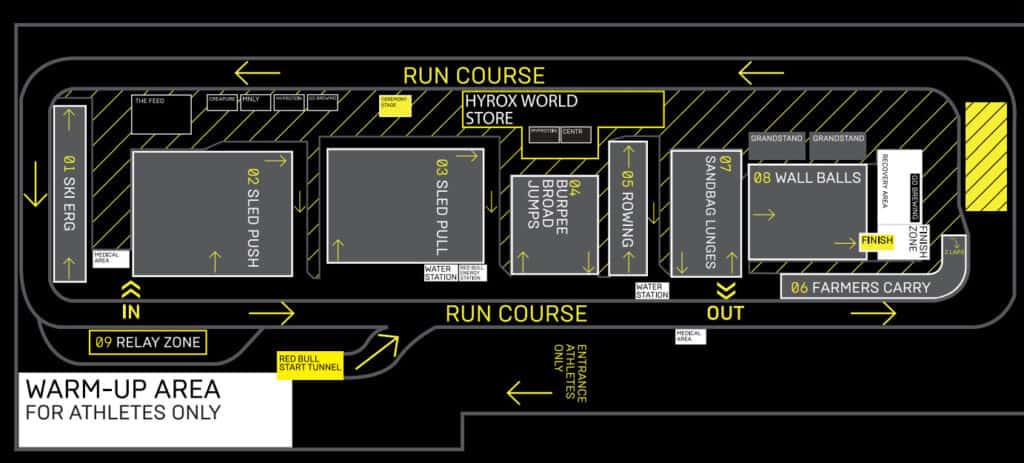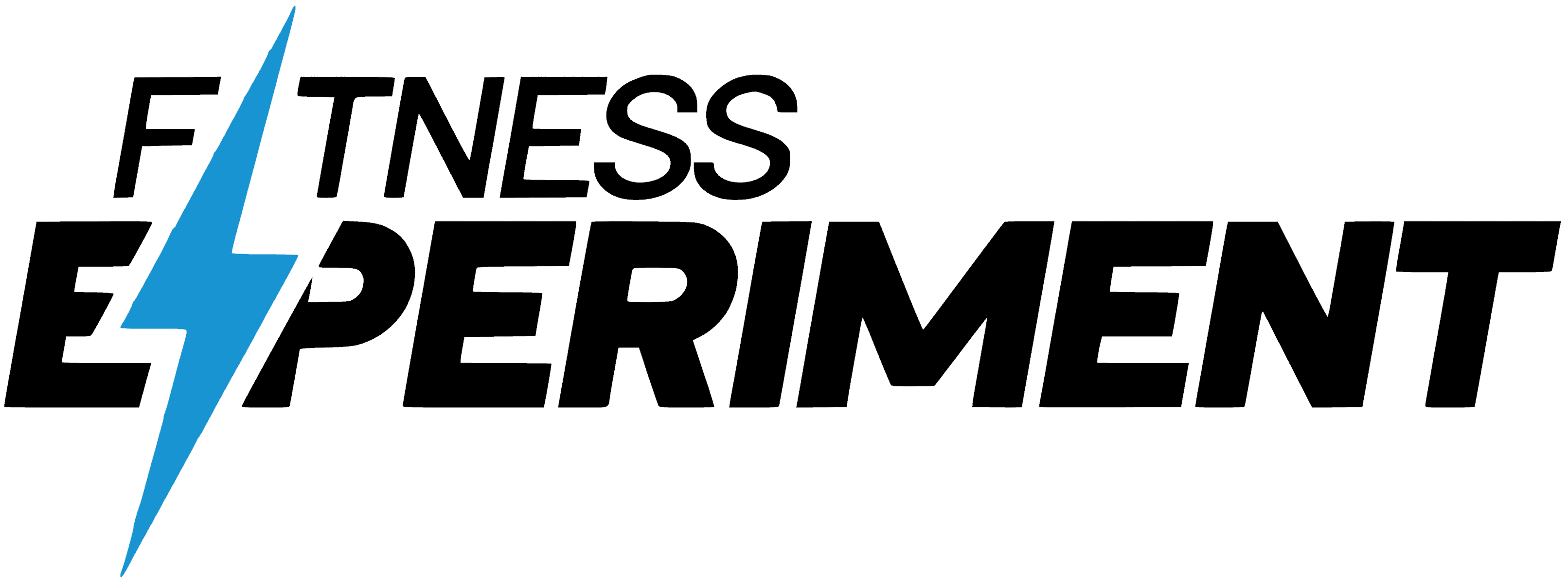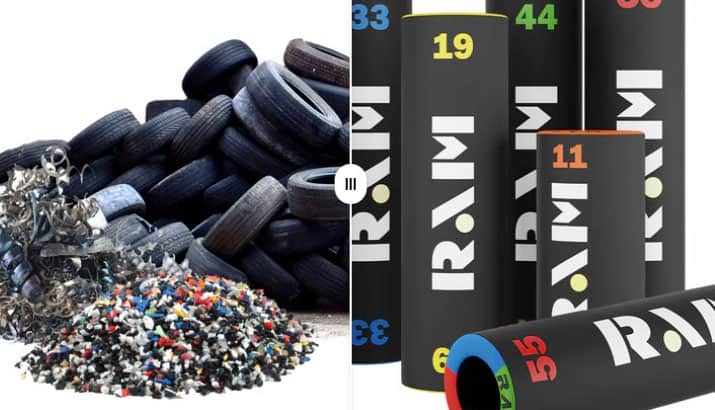A HYROX race consists of 8 functional fitness stations (or exercises), each preceded by a 1km run. In total, you perform 8 1km runs, and perform work at 8 different stations. Each HYROX station contains a different movement with a unique weight, distance, or rep requirement.
HYROX races always take place indoors in large exhibition halls. The running usually takes place on the outside of the hall, while all the exercises are placed inside of the running track.
You’ll run 1km, head in to complete your first workout station, then head back out on your next 1km run. You repeat this 8 times.
Let’s discuss the station order, race format, layout, and explain the distance and rep requirements for each HYROX station.
HYROX Stations
The 8 HYROX stations, in order, are:
- Ski – 1000m
- Sled Push – 50m
- Sled Pull – 50m
- Burpee Broad Jumps – 80m
- Row – 1000m
- Farmer’s Carry – 200m
- Sandbag Lunges – 100m
- Wall Balls – 100 reps
For each HYROX division, the distances & reps remain the same (exception: adaptive divisions). However, different weights are used depending on which division you’re competing in. See our guides below 👇
- All HYROX weights, by division & station →
- Learn more about HYROX Doubles and the HYROX Relay
- Simplified version of all the HYROX rules →
Now let’s break down the 8 HYROX stations, sometimes referred to as HYROX exercises.
1. 1000m Ski
The ski is the very first HYROX station, after completing your first 1km run. All HYROX races use a Concept2 SkiErg for the ski.
All HYROX divisions complete 1000m on the ski before moving on to their second 1km run.
Doubles teams can split up the 1000m ski however they’d like. One person can do all 1000m, you can split it 500m apiece, switch every 100m, etc.
👇 We break down the ski setup, strategy, and more in our comprehensive guide below.
- Complete guide on the HYROX ski station → (coming soon)
2. 50m Sled Push
After completing your second 1km run, you’ll enter the sled push station. All participants must complete 50m of a sled push.
The 50m is broken up into 12.5m sections. You’ll push down 12.5m. Then push the sled another 12.5m back to its starting position. Repeat this down and back one more time for a total of 50m.
Once completing the sled push, you’ll head out (usually the opposite way you entered) for your third 1km run.
👇 We break down the sled push setup, strategy, and more in our guide below.
3. 50m Sled Pull
After your third run, you’ll enter the sled pull station. The setup looks similar to the sled push, with the same 12.5m sections. Only this time, you use a rope to pull the sled 12.5m, then jog down to the other side, and pull the sled back with a rope attached to the opposite side of the sled.
You’ll complete a total of 50m of sled pull before heading out for run #4.
👇 We break down the sled pull setup, strategy, and more in our guide below.
4. 80m Burpee Broad Jumps
The fourth HYROX station is the burpee broad jumps. When you arrive to this station, you start with your hands and feet behind the starting line. You’ll do a burpee, then jump forward. You’ll continue to do a burpee plus a jump, until you have completed all 80m.
Each race might have a slightly different burpee broad jump setup, but most venues have either:
- 80m in one continuous length
- 40m down, 40m back
- a zigzag pattern with ~20m lengths (i.e. down, back, down, back)
👇 We break down burpee broad jump setup, strategy, and more in our guide below.
- HYROX burpee broad jump guide → (coming soon)
5. 1000m Row
The 1000m row is the fifth HYROX station. All HYROX races use a Concept2 RowErg for the row station.
All HYROX divisions complete 1000m on the row before moving on to run #6.
You’ll enter the row station, go to the row that the judge instructs you to, adjust your damper and foot straps, row 1000m, and then exit the station from the opposite end you entered. You must remain in your seat until your screen shows 1000m.
Doubles teams can split up the 1000m row however they’d like. One person can do all 1000m, you can split it 500m apiece, switch every 100m, etc.
👇 We break down the row setup, strategy, and more in our comprehensive guide below.
- HYROX row setup, strategy & tips → (coming soon)
6. 200m Farmer’s Carry
The sixth station in HYROX is the farmer’s carry. Athletes will carry two kettlebells at their sides a total of 200m (see farmer’s carry weights by division). Athletes may walk, jog, or run, but must be carrying both kettlebells at their sides in order to make forward progress.
The farmer’s carry course differs from race to race, depending on the venue. You might see…
- 2 laps of 50m down and back
- 1 lap of a zigzag course, each down & back at varying lengths
👇 We break down the farmer’s carry setup, strategy, and more in our comprehensive guide below.
- HYROX farmer’s carry guide → (coming soon)
7. 100m Sandbag Lunges
After the farmer’s carry comes the sandbag lunges. You’ll enter the 7th HYROX station, load a sandbag on your back (see lunge weights by division), start behind the starting line, and lunge until you’ve completed 100m.
- You must lunge forward and alternate feet
- You may not shuffle or step your feet between lunges
- Dropping the sandbag will incur a penalty
HYROX lunge courses also vary by venue.
- 50m down and back
- ~25m down and back, in a zigzag format
👇 We break down the sandbag lunge setup, strategy, and more in our resource below.
- HYROX sandbag lunge strategy guide → (coming soon)
8. 100 Wall Balls
Wall balls are the 8th and final HYROX station. Once you’ve completed your 100th wall ball, congratulations 🎉. You are now a HYROX finisher!
You’ll enter the wall ball station after your 8th 1km run. Judges are usually there to direct you to a specific lane. Make sure you pick up the correct weight ball, squat below parallel, and hit the correct target.
👇 We discuss the wall ball setup, strategy, and more in our guide below.
- HYROX wall ball station guide → (coming soon)
HYROX Race Format & Layout
HYROX is a standardized fitness race, with the same movements, same distances, in the same order, every race. However, there are slight variations in the race format, as each race takes place in a different venue. And not all venues allow for an identical setup each time.
Here’s an example HYROX race layout from the North American Championships in Washington, DC, USA in March 2025.
- The yellow striped rectangle on the far right is where spectators cross into the viewing area
- The black with yellow striped area is open to spectators to watch the action

The HYROX race format will always contain the following:
- The HYROX start tunnel
- A running track around the outside of the venue
- Workout stations situated inside of the running track
- Some additional space inside the running track, before you reach each workout station (aka: the Roxzone)
- Finish line
Start Tunnel
This is one of the most unique & exciting aspects of a HYROX race, especially if it’s your first time. At every event, HYROX builds an inflatable start tunnel where all athletes gather before they start the race.
It’s a darker, semi-enclosed environment, with lights and a separate speaker system to hype you up before you start. There’s a hype person to give you a pep talk before it’s go time, and a countdown clock counts down the seconds before you take off.
⚡️ I can almost guarantee it’ll be one of the most electric starts to a race you’ve ever experienced.
Once you take off, you’ll immediately be sent onto the running track…
Running Track
Due to venue differences, the HYROX running track is different at each event. In general, it will resemble an oval shape, and run around the outside edge of the venue.
- Some running tracks are about 300m in length, requiring 3 laps to complete 1km
- Some are closer to 250m in length, requiring 4 laps to complete 1km
- A few might be around 500m in length, requiring only 2 laps to complete 1km
Please reference your specific HYROX race map to see how many laps you need to complete.
The running track contains two lanes—a fast lane and a regular lane. Try to stay in the regular lane, unless you are passing someone. As each new wave of athletes is released, they will likely take off in the fast lane, so be aware of your surroundings.
Once you’ve completed your 1km run around the track…
In & Out Arches
The in & out arches are an important component to understanding the HYROX race format. These are the openings in the running track where you will enter and exit the running track to go in and out of the Roxzone, where all the workout stations are found.
They are usually located on the same side of the running track, but sometimes the in arch will be closer to the start line, and sometimes the out arch is closer. It just depends on your venue.
You always enter the Roxzone through the IN arch and exit the Roxzone back onto the running track via the OUT arch. Penalties are assessed for going in or out the wrong arch.
Roxzone
As soon as you exit the running track to head to a workout station, you enter what is called the Roxzone. You may walk, jog, or run through the Roxzone to get to the station you need to complete.
The Roxzone at each race is different, but your split times will include how much time you spent in the Roxzone throughout the race.
Most hydration stations are found within the Roxzone.
It’s important to note that while you might think a HYROX race consists of 8km of running (8 x 1km laps), HYROX has stated that the running laps combined with the distance in the Roxzone always equals 8.7km total.
You will run in the Roxzone to find the arch with the name/number of your next station.
Workout Stations
At every HYROX, the 8 workout stations are always contained within the inside of the running track. However, they are not always in the same order, or even the order that they are to be completed. It’s your responsibility to remember which station you are on, and find the appropriate arch for that station.
You’ll enter through the station arch to complete your station work.
Upon finishing your station work, you’ll travel through the Roxzone, but this time you’ll look for the OUT arch to get back onto the running track.
Finish Line
You’ll complete this process 8 times, and finish with the final station, wall balls. There is no run after the wall balls—you run up the ramp to the finish line, where you can look for your name & finishing time on the giant screen.
And that is the HYROX layout, in a nutshell.
Merch, Sponsors, Spectators, Etc.
Outside of the actual race, you’ll find additional things at every HYROX event:
- Registration
- Bag drop
- Spectator grandstand
- Sponsor booths
- Merchandise area
- Relay exchange zone
- Hydration stations
- Medical station
- Recovery area
- Finish zone
- Ceremony stage
Many of these are self-explanatory, but let’s discuss the ones that affect the actual format of a HYROX race.
Spectator Grandstand
You might also see this referred to as the “HYROX Thunderdome,” but this is essentially a large seating area for spectators to watch the event. It is almost always situated in and around station 8, the wall balls.
Any athlete or spectator may visit this area as often as they’d like throughout the day to watch the action unfold.
Hydration Stations
If you need water or electrolytes during the race, there are one or two stations where you can find replenishment. The hydration stations are usually located inside of the Roxzone, but this varies by venue. Look at your specific race map to see where they are located for your race.
Relay Exchange Zone
The relay exchange zone is only for those competing in the HYROX relay division. This is where your relay partners will be staged as they wait for you to complete your leg. Once you’ve finished your 1km run and subsequent station, you’ll enter the relay exchange zone, locate the athlete on your team assigned to the next leg, and tag them in.
Finish Zone
The finish area is the final part of a HYROX course that you’ll encounter, and it’s an exciting one. All HYROX races finish up a small ramp and on a small stage, backed by a massive screen with finishing times, as well as lights and a DJ.
Once you’ve completed your 100th wall ball, head up the ramp and between the two pillars to finish your race on the HYROX finishers stage.
When you’re ready to sign up for a race, check out our guide to HYROX tickets, including some important changes for the 2025/26 season.
If you have any questions about the HYROX stations or race format, please reach out on Instagram (@fitnessexperiment.co). We’d be happy to help 😀.









